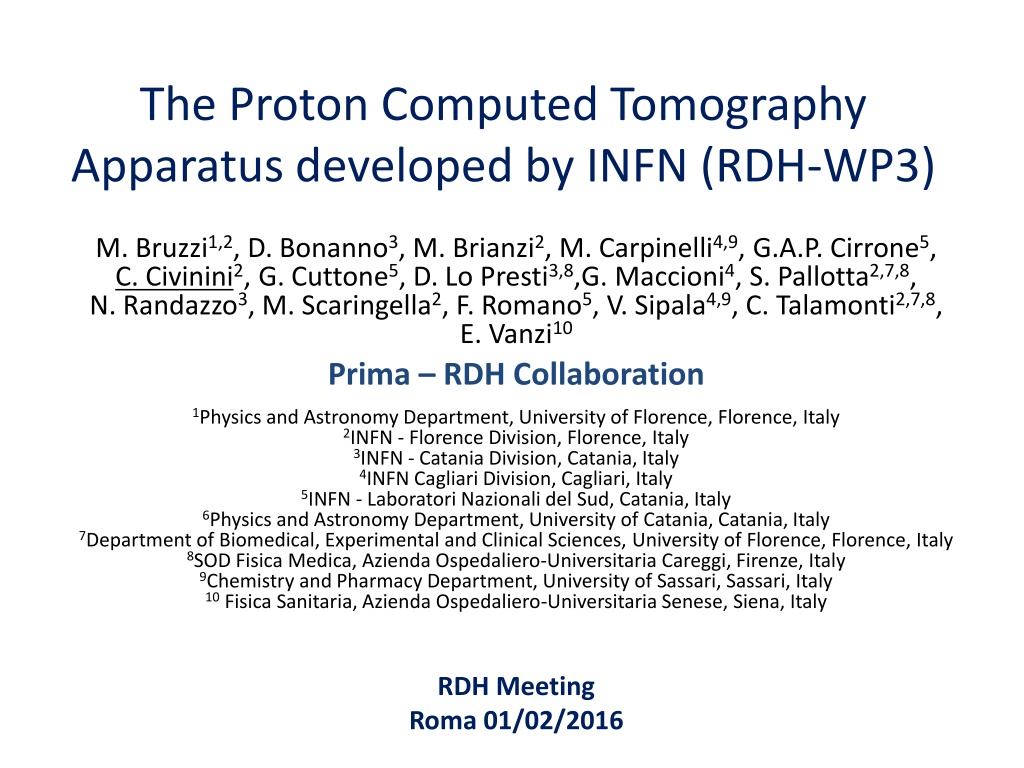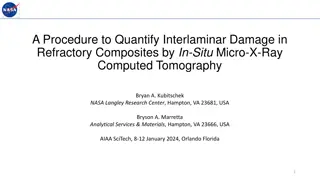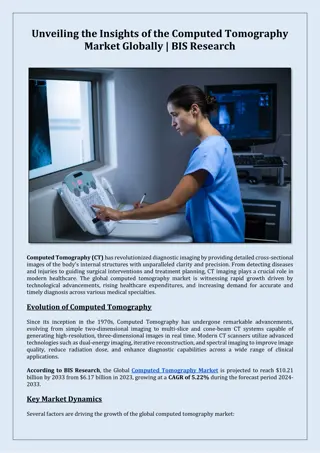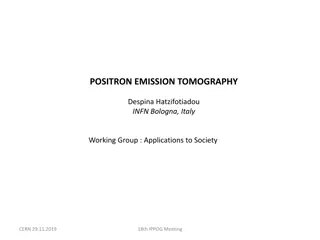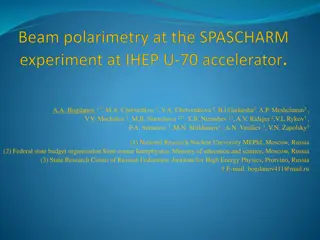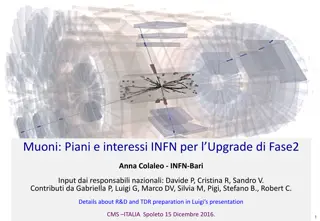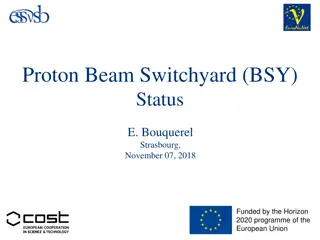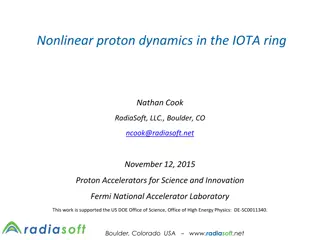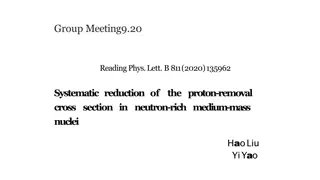Development of Proton Computed Tomography Apparatus by INFN (RDH-WP3)
The Proton Computed Tomography Apparatus, developed by the INFN (RDH-WP3) collaboration, consists of two pCT systems for high-energy tomography. Various tests and analyses have been conducted, with plans for further testing in 2016. The system utilizes Algebraic Reconstruction Techniques and silicon microstrip detectors for accurate imaging of proton entry and exit positions. The collaboration's efforts aim to enhance the capabilities of proton imaging in the medical field.
Download Presentation

Please find below an Image/Link to download the presentation.
The content on the website is provided AS IS for your information and personal use only. It may not be sold, licensed, or shared on other websites without obtaining consent from the author. Download presentation by click this link. If you encounter any issues during the download, it is possible that the publisher has removed the file from their server.
E N D
Presentation Transcript
The Proton Computed Tomography Apparatus developed by INFN (RDH-WP3) M. Bruzzi1,2, D. Bonanno3, M. Brianzi2, M. Carpinelli4,9, G.A.P. Cirrone5, C. Civinini2, G. Cuttone5, D. Lo Presti3,8,G. Maccioni4, S. Pallotta2,7,8, N. Randazzo3, M. Scaringella2, F. Romano5, V. Sipala4,9, C. Talamonti2,7,8, E. Vanzi10 Prima RDH Collaboration 1Physics and Astronomy Department, University of Florence, Florence, Italy 2INFN - Florence Division, Florence, Italy 3INFN - Catania Division, Catania, Italy 4INFN Cagliari Division, Cagliari, Italy 5INFN - Laboratori Nazionali del Sud, Catania, Italy 6Physics and Astronomy Department, University of Catania, Catania, Italy 7Department of Biomedical, Experimental and Clinical Sciences, University of Florence, Florence, Italy 8SOD Fisica Medica, Azienda Ospedaliero-Universitaria Careggi, Firenze, Italy 9Chemistry and Pharmacy Department, University of Sassari, Sassari, Italy 10Fisica Sanitaria, Azienda Ospedaliero-Universitaria Senese, Siena, Italy RDH Meeting Roma 01/02/2016
Introduction Two pCT systems: 5x5cm2; 5x20cm2 Analysis results from the small area system Algebraic Reconstruction Technique Uppsala June-2015 test High energy Tomography Large area apparatus status Tracker Calorimeter 200 MeV tests Plans for 2016 February 1st 2016 Carlo Civinini INFN-Firenze 2
PRIMA collaboration: small area pCT apparatus First test at INFN-LNS: May 2011 High energy test at TSL-Uppsala: June 2015 Proton entry and exit positions and directions Proton residual energy Four x-y silicon microstrip based tracking planes Yag:Ce calorimeter February 1st 2016 Carlo Civinini INFN-Firenze 3
Algebraic Reconstruction Techniques The system could be solved using an iterative formula: Sk+1= Sk+ k ? ??{(pi- <wi,Sk>) wi} / wi 2 Gordon, R; Bender, R; Herman, GT J. Theor. Biol. (1970) 29 (3): 471 81. Skimage vector at iteration k (stopping power) wiithtrack length in each pixel (vector) Tracker pistopping power integral (number) Calorimeter krelaxing factor (constant value or 0 as ~k-1) S0initial image: {0} or approx (i.e., from FBP reconstruction). Three algorithm variants (depends on the events in Akset): Ak= {1-event}: ART too much salt-pepper noise Ak= {full data set}: SART (simultaneous ART) better noise Ak= {1/n of the full data set}: BI-SART (n-Block iterative SART) good noise performance with faster convergence September 22nd 2015 C. Civinini - INFN Firenze - SIF 2015 4
Most Likely Path in a pCT geometry Starting from D.C. Williams Phys. Med. Biol. 49 (2004) and R.W. Shulte at al. Med. Phys. 35 (11) (2008) 5 cm of air have been inserted in front and behind the 20cm H2O phantom MLP example with 200MeV kinetic energy protons in 20cm of water: Entry: Y(0) = 0.2cm Y (0) = -10mrad Exit: Y(20) = -0.1cm Y (20) = +10mrad Silicon microstrip detectors: 320 m thick 200 m strip pitch MLP error envelope plus contributions from detector position measurement error (~ pitch/ 12) and MCS inside the silicon sensors The sensor thickness contribution affects only the MLP error at the edge of the phantom ~ 150-250 m 200MeV in 90MeV out February 13th 2015 C. Civinini - INFN Firenze - Garching 2015 5
Uppsala 2015 Test Beam Performed at The Svedberg Laboratory (TSL-Uppsala) 24 hours beam time (550 /hour) + beam setup (2200 ) Beam energy at pCT detector (phantom): 172.5 0.9 MeV Instantaneous beam intensity: 10kHz Cyclotron duty cycle: 10% Mean DAQ frequency: 1 kHz Data sets: Calorimeter calibration: 106events at 78, 121, 160 MeV (no phantom) Tracker alignment: 3*106events at 173 MeV (no phantom) 40 angles (0o-351 ): 1.5*106events per angle Radiography: 1.5*106events February 1st 2016 Carlo Civinini INFN-Firenze 6
Uppsala set-up February 1st 2016 Carlo Civinini INFN-Firenze 7
Phantom mounted on pCT system February 1st 2016 Carlo Civinini INFN-Firenze 8
Uppsala test: phantom Phantom dimensions limited by the system field of view (5cm) To have a reasonable energy measurement error the phantom material could not be plastic-like: EPMMA(5cm)~22MeV (to be compared with the calorimeter resolution at 200MeV Ecalo~4-5MeV) We decide to use Aluminium for the phantom body with Iron and Copper insert to simulate high constrast material (e.g., muscle-bone structure) An empty hole and a uniform section have been made to evaluate space resolution for different constrast and density r.m.s. measurement During data taking the phantom is rotated by 9 using a remotely controlled micro-step motor (step angle = 1.8 ) =4mm =3mm =2mm =6mm 45mm February 1st 2016 Carlo Civinini INFN-Firenze 9
Algebraic algorithm implementation Iterative algebraic algorithms have a rather high computing cost Using a sequential CPU, and moving a lot of computing from the algorithm itself to the preprocessing phase, a 50-iterations image takes about 3+3 hours to complete with little space for improvement Parallel computing on GPUs is a way to decrease the computation time at the expense of a learning phase Hardware: NVIDIA GeForce GTX TITAN X (not so expensive: ~1000 Euro, 12GB memory, 3072 Cuda cores, 24 Multi- processors, 786432 parallel threads) Software: Cuda on Visual Studio (Community edition, free) February 1st 2016 Carlo Civinini INFN-Firenze 10
GPU parallelism All data (tracker coordinates and calorimeter energy) is copied from disk to GPU memory once at the beginning of job (~2GB) The Most Likely Path is recalculated at each iteration (GPU general rule : faster to recompute than store on disk and recall) Most of the algorithm operations are pixel-by-pixel: use one thread per pixel (up to a maximum of 512x512 pixels) Some calculations are independent: use the stream on GPU to further parallelize them (e.g., the MLP calculation is done on the shadow of the BI-SART algorithm, so no computing cost for it) Move the reconstructed images only from GPU to CPU to store them on disk at the end of each iteration The preprocessing phase takes about 1 -2 for the whole dataset One iteration on GPU now costs 1 15" for a 512x512 pixels image with 2x106events (128x128 pixels image is iterated in less than 10") February 1st 2016 Carlo Civinini INFN-Firenze 11
CUDA timeline Kernel: some code executed on different threads (e.g., 1 thread per pixel) time Different kernels are executed in parallel on different streams Group of 16 events February 1st 2016 Carlo Civinini INFN-Firenze 12
BI-SART reconstructed tomographies Images shown here are obtained using a 4-blocks BI-SART algorithm, with relaxation parameter ( k) chosen to have the density r.m.s. minimum around iteration 10 No a-priori knowledge of the phantom boundary is requested (only an external larger container is known to the algorithm) The proton tracks are calculated using the Most Likely Path formulas (MLP operators, ~300MB, stored in GPU memory) The phantom is divided into 5 slices, each vertically uniform Slice thickness: 4-6mm At the moment only a 2D reconstrution version is available vertically project a slice onto a plane The color palette indicates the Stopping Power (at 175 MeV) as it is calculated by the algorithm February 1st 2016 Carlo Civinini INFN-Firenze 13
BI-SART starting for empty picture Iteration 11 February 1st 2016 Carlo Civinini INFN-Firenze 14
Resolutions BI-SART (from {0} BI-SART (from {0} 650 m at iteration 11 0.96% at iteration 11 The edge resolution has been obtained fitting the edge of the tomography with an error function and quoting the sigma The density resolution is the r.m.s. of the pixel stopping power distribution taken in a uniform fiducial region of the phantom February 1st 2016 Carlo Civinini INFN-Firenze 15
Insert resolution BI-SART (from {0} The Stopping Power values at iteration 50 are the following: Aluminium: 10.9 MeV/cm (expect. 10.4 MeV/cm) Iron: 26.45 MeV/cm (expect. 27.03 MeV/cm) Copper: 28.7 MeV/cm (expect. 29.53 MeV/cm) 960 m at iteration 11 Comments: probably the insert tolerance w.r.t. the hole decreases the measured SP, as a matter of fact for Fe and Cu a 2 3% underestimation is observed); The +5% overestimation observed for the Aluminium could be ascribed to the material used which is not pure Al but anticorodal. The internal insert resolution has been obtained fitting the edge of the 6mm diameter inserts with an error function and quoting the sigma February 1st 2016 Carlo Civinini INFN-Firenze 16
Filtered Back Projection reconstructed tomographies The Filter Back Projection algorithm assume a parallel beam with straigth tracks This is not true for protons because of multiple scattering Nonetheless we apply the FBP algorithm to reconstruct a pCT image This image could be eventually used as a starting point (seed) for the iterative algorithm FBP edge resolution: 600 m FBP density resultion: 1.8% FBP internal insert resolution: 900 m Same spatial resolutions of BI-SART with a factor two worser density resolution February 1st 2016 Carlo Civinini INFN-Firenze 400 m pixel size, SP normalized to BI-SIRT image FBP hard filter 17
BI-SART starting from FBP Starting from {0} Starting from FBP Better spatial resolution Much more uniform February 1st 2016 Carlo Civinini INFN-Firenze 18
BI-SART starting from FBP Starting from {0} Starting from FBP 0.96% 1.55% Better uniformity February 1st 2016 Carlo Civinini INFN-Firenze 19
BI-SART starting from FBP Starting from FBP Starting from {0} 400 m at 11 340 m at 50 650 m at 11 400 m at 50 Better spatial resolution February 1st 2016 Carlo Civinini INFN-Firenze 20
pCT upgrade (5x20cm2) A system similar to the one already tested Microstrip tracker YAG:Ce calorimeter But with a 50 x 200 mm2field of view On-line data aquisition 1 MHz capability Rectangular aspect ratio to perform tomographies in slices Phantom Beam pipe Tracker planes Silicon sensors Calorimeter February 1st 2016 Carlo Civinini INFN-Firenze 21
Fully assembled Tracker plane Chip front-end Silicon strip Master FPGA Virtex6 Slave FPGAs February 1st 2016 Carlo Civinini INFN-Firenze 22
New tracker plane New tracker front end chip Better I2C functionality Less threshold dispersion New version of the printed board FPGA programmability issues solved New buffer chips The new front-end chips have been delivered last november The new printed board, delivered in november too, had mounting problems (we should received it from last iteration this week) In the meanwhile problems to the INFN-Florence bonding machine (discontinued by Delvotech, repaired by our technician) This week: test of the new front-end chip on the new tracker board February 1st 2016 Carlo Civinini INFN-Firenze 23
2016 High energy runs (200 MeV) Need O(100kHz-1MHz) instantaneous intensity beam Calorimeter/scintillator (preliminary) Test of the extended view pCT system (Spring 2016) One/two Tracker bords + Calorimeter integration Noise performance Rate capability Data acquisition for tomography (second half of 2016) Full pCT system with different phantoms February 1st 2016 Carlo Civinini INFN-Firenze 24
2016 pCT plan Analysis 3D reconstruction, algebraic algorithm evolution, reconstruction parameters optimization Extended view pCT system Validate the tracker plane, calorimeter and DAQ integration Test at LNS, April 2016 Production and assembly of the 4/5 final tracker planes (PCB and front-end chips) by June 2016 Data taking with the full system during second half of 2016 (at least two runs) February 1st 2016 Carlo Civinini INFN-Firenze 25
Algebraic Reconstruction Techniques Iterative algorithm to reconstruct tomographic images (proton stopping power maps) from projections (for pCT set of single proton events) Starting point (S(x,y,E) stopping power): Introducing the mass stopping power S/ : E0= a fixed energy (200 MeV or ... 60 MeV in our case) September 22nd 2015 C. Civinini - INFN Firenze - SIF 2015 26
Algebraic Reconstruction Techniques Dividing by S/ at energy E: The left hand side doesn t depend too much on the material composition (~2-4*10-3) and could be replaced by the one measured for liquid water (NIST pstar tables - http://physics.nist.gov/PhysRefData/Star/Text/PSTAR.html): September 22nd 2015 C. Civinini - INFN Firenze - SIF 2015 27
Algebraic Reconstruction Techniques Integrating along the proton path: Wang, Med.Phys. 37(8), 2010: 4138 Einis given by the accelerator, Eoutby the calorimeter and the path by the tracker (Most Likely Path) Subdividing the object into a set of pixels, for the ith proton: Where wijis the path length of proton i inside the pixel j September 22nd 2015 C. Civinini - INFN Firenze - SIF 2015 28
Pixel 1 Pixel j p out 90 MeV Phantom: 20 cm of water Computational challenge: find the simplest (fastest) way to build the wij matrix (could have billions of elements, most of them equal to zero) p in 200 MeV wij Pixel N September 22nd 2015 C. Civinini - INFN Firenze - SIF 2015 29
Algebraic Reconstruction Techniques The problem is then to solve, for Sj, the following set of equations: N = number of pixels; M number of protons In our case: N = (250x250)=62500 pixels M ~ 36(angles)*106events September 22nd 2015 C. Civinini - INFN Firenze - SIF 2015 30
Read-out group Silicon microstrip detectors Front-end chips Power regulators FPGA slave February 1st 2016 Carlo Civinini INFN-Firenze 31
February 1st 2016 Carlo Civinini INFN-Firenze 32
Calorimeter calibration and Tracker alignment Using four energy points in the range 78-172 MeV, the calorimeter has been point-by-point calibrated (400 cells, 3x3mm2each). The tracker has been aligned using 2x106events taken without phantom: Plane no. 3 has been fixed (absolute reference frame) Furthermore, for each of the other planes: out of 6 degrees of freedom 3 have been fixed ( z, , ) and three free to vary ( x, y, ); Global minimization of the residuals has been done x~(300 500) (40 70) m (horizontal position has no mechanical constraint screw tolerance) y ~(30 90) (40 70) m (vertical position easier to be mechanically constrained) ~(1 3) (0.3 0.7)mrad February 1st 2016 Carlo Civinini INFN-Firenze 33
Data preprocessing The ~6x107tomography events have been preprocessed in order to remove three main source of background 1. Multiple protons 2. Nuclear interactions in the calorimeter 3. Elastic nuclear interactions in the phantom/silicon sensors Events of categories 1) and 2) are cut using an energy compatibility criterion (-9+8MeV from the expected energy), while events of category 3) are removed using the proton scattering angle (more than 3 sigma away from expected MCS) February 1st 2016 Carlo Civinini INFN-Firenze 34
New YAG:Ce calorimeter data 60 MeV =3.9% Double protons=120 MeV Noise = 10 MeV ADC counts February 1st 2016 Carlo Civinini INFN-Firenze 35
YAG:Ce calorimeter Data Acquisition System 2x7 YAG:Ce Crystals Array Size: 3x3x10cm3 CHASSIS NI PXIe-1071 FlexRIO NI PXIe-7962R 14 Analog Channels Ad.Mod. NI-5751 Parallel read-out Sampling: 5MS/s 24 Samples x event 7Dig I/O GEN Disable Trigger Dig. Trigger RT Controller NI PXI-8102 Silicon Photodiodes 1.8x1.8cm2 Tracker x14 February 1st 2016 Carlo Civinini INFN-Firenze 36 Fast Charge Amplifier + Shaper
